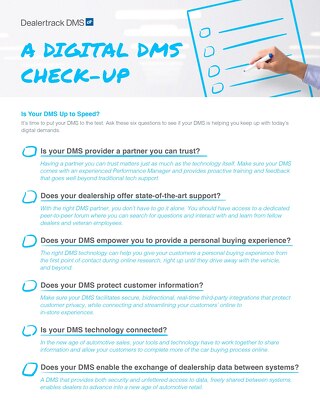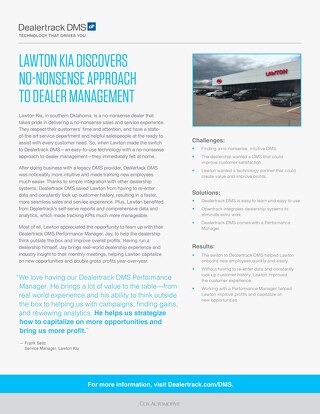Dealers purchase technology to increase their profitability. That makes sense. After all, you wouldn’t invest in new digital steps if they cost more money than they were worth. And, if you’re like a lot of dealers in the last year, you’ve added at least one new technology to your business. According to the 2020 Digitization End-to-End Study from Cox Automotive, 69% of franchise dealers did just that. And it seems to be paying off. Overall buyer satisfaction rates hit an all-time high of 72% recently. Yet, dealers tend to overlook the major role their DMS technology plays in driving profit and saving money. The reason? It’s not always obvious…at first.
Profit Driver vs. Utility
According to Randy Wilson, director of Performance Management at Dealertrack, “A DMS is required to function.” Simply put, most dealers tend to view the Dealer Management System as a utility—not a profit driver. “But,” he emphasizes, “it’s critical to the profitability of today’s new digitized landscape. Your DMS holds much of the data required to run payroll, for example.” You may not have considered your DMS as much more than a utility running in the background for the past twelve months. But, while you were working on navigating the changes needed to adapt to a more digitized landscape, your DMS was likely feeding each new system the data needed to fully function. Businesses have been busy scaling up technology like never before in the wake of lockdowns, furloughs, and new social norms. In the same 2020 Cox Automotive Study referenced above, 84% of franchise dealers expected to increase online sales in 2021. With so much rich data being delivered to all the major departments of your business, a DMS that could leverage the right data, at the right time, would set up any dealer for success. (And a failure to do so would lead to the opposite.)
More Than Money
You may have spent the last year increasing your digital reach to find the right customer and match them with the right car. But, having the wrong technology can cost you more than just money. Many departments within your dealership operate almost independently from each other. Escaping the siloed nature of our industry may not be possible, but one thing is certain: everyone is impacted by the DMS. Buyers may have changed the way they interact with your dealership, but speed and efficiency are still king. The ability to deliver a superior experience whether in-person, online, or a hybrid of the two will rely heavily on your team’s operational efficiency. Stubborn and complicated interfaces, workflows that create manual re-entry of data, and systems that don’t communicate across departments can hinder your success. All data begins and ends with your DMS. A failure to optimize can cost you in team performance, turnover, and time.
Sneaky Fees Hurt Where it Counts
Technology can connect your business to more data, more customers, and more profit potential. But at the end of the billing cycle, the growth you had expected may come up short. Was it margin compression or something more sinister? Sneaky fees may be hiding in plain sight—and they’re easy to miss. With the average dealership transaction requiring up to 7 technology systems to complete, integration fees could be driving up the cost of doing business. When your DMS provider treats each third-party vendor you work with like a sales opportunity, they’re able to charge exorbitant fees against you. And it adds up to the tune of about $42,000 every year! That’s according to a Cox Auto Community Poll from 2017, which means, those fees are likely higher now. New restrictions on first-party data are going to up the ante on your DMS provider’s data access fees. This means that the true cost of DMS technology depends on how open and transparent your DMS partner chooses to be.
Ultimately, the technology driving your dealership should deliver better business decisions. It should reduce backlogs of old data, manual re-entry, and clumsy reporting that hinders your operations. And, it shouldn’t charge exorbitant or hidden fees. Finding the right partner is more important than ever. Your profitability depends on it.
Looking for an end-to-end software solution that streamlines operations and drives profitability? Speak with the team at Dealertrack DMS at Dealertrack.com/DMS.
A version of this article originally appeared on Wards Auto here.















